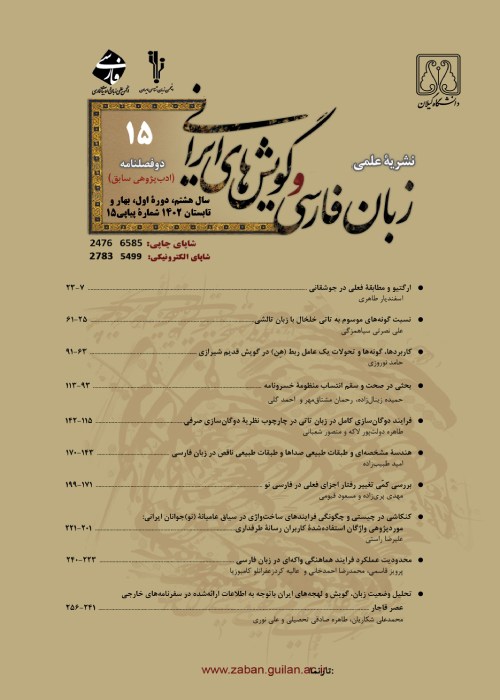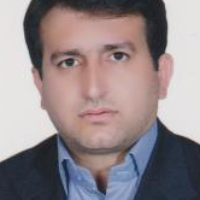The Pronunciation Effect of Persian Language on Mazandarani Language (Saravi Variety)
The study of language in the social context as well as the influence of language on another language has always been of interest to sociolinguistics. In this study, the effect of phonetics and phonology of Persian language on Mazandarani (Saravi variety) has been investigated. The present study is a descriptive-analytical field study that describes and analyzes data to investigate the effect of phonetic and phonology of Persian language as an independent variable (and the effect of social factors of age and geographical area as a moderating variable) on Mazandarani as a dependent variable. In this study, questionnaire, interviews and audio recordings were used and the participants included different age groups of girls and boys ages 14-18 (youth), women and men between 30-40 years (middle age) and over 50 years (adults). They were classified randomly from urban and rural areas of Sari. The results show that the Mazandarani language is about to change and become Persianized by interfering with processes such as analogy and overgeneralization in different rural and urban generations. The present study can be used by sociolinguistics and language planners to provide a new analytical horizon for language development and change.
The dominance of Persian over other local languages has led to changes in the culture of Mazandarani people. In this study, considering the developments of literacy and teaching Persian, media and development of communication and tourism, and the neighbor hood of Tehran, Persian impacts on Mazandarani pronunciation of Saravi variety. Two Japanese researchers called Navata (1984) and Yoshie (1996) did surveys titled " Mazandarani " and another as "Sari dialect" . The Saravi dialect was written " by Shukri (1995). Another research was done about the structural analysis of Mazandarani verbs by Samare (1988). Amouzadeh (2002) studied and explained the cultural and social aspects that play a role in the decline of the Mazandarani languageAnalogy and overgeneralization are the processes that have been studied in this research as influential factors on the Mazandarani language.
Theoretical framework of this research is Critical Applied Linguistics based on the newfound approach of Cook (1990). The main objective in this study is a description of the process of changing the characteristics of phonetic - phonological of Mazandarani Saravi variety from the perspective of the change of language by comparing urban and rural speakers speech in different age with standard and colloquial of Persian language.
This research is a field study, data analysis and description of the available facts, it surveyed the effect of pronunciation of Persian on the Mazandarani language as a dependent variable by some social factors as moderating variables. Questionnaire and interview were used to collect data . Participants included girls and boys in the age groups of 14-18 years (youth) and age groups of 30-40 years (middle-aged) and over 50 years (adults) who were randomly selected from urban and rural areas of Sari.
In the original phonetic system of Mazandarani (Sarvai variety), the number of consonants is 22 and the number of vowels is 7 and the difference with Persian was due to the phoneme / ʒ / . One of the phonetic differences between the urban and rural consonants of Mazandarani is labialization feature of consonants: / x, k, g / [ x w , k w , g w ]> [x, k, g] . The lack of labialization feature in pronunciation urban Saravi is due to the influence of Persian. Elimination of this feature in the young rural generation is expressed in moderate forms, which indicates a gradual change. The deletion of /h/ and /ʔ/ consonants has occurred in terms of the ease of Persian language in the urban and rural Saravi variety by analogy. Parts of speech in Mazandarani were increasingly borrowed from Persian. For example, adjectives are used before nouns in Mazandarani and after nouns in Persiam. When borrowed adjectives are used in Mazandarani, the order of words usually changes as in Persian. Young urban Saravi speakers sometimes change verb roots by producing a new infinitive to be under the influence of interference of Persian. The change of /o/ in be-ʃno- ‘hear’to /e/ in be-ʃne- which young people think has become Mazandarani, is an example of the overgeneralization of the root of the verb, because in many cases the young Sarvai speakers are less fluent in Mazandarani. They change /a/ and /o/ to /e/ to make the words look like Mazandarani, which is a possible result of comparison with a pair of words in two languages, and another possibility could be the result of the influence of Persian because ʃenid ‘heard’ has a vowel /e/. Moreover, the urban young and middle aged speakers are doing innovation between the two infinitives in two languages, without any historical connection. In this case, a similar process occurs in which the verb prefix and the identifier are added to the root of the Persian verb. There are some cases where young urban speakers use overgeneralization process such as : /pɛːdɒ/ in the speech of rural speakers - /pidɒ/ in the speech of urban speakers and /peidɒ / in Persian which means ‘visible’. Urban speakers often use Persian subject pronouns instead of Mazandarani subject pronouns for all persons. The data show that urban speakers used the plural reference pronouns of colloquial Persian rather than Mazandarani subject pronouns.
In the field of phonology, / ʒ/, as a result of lexical borrowing items is borrowed from Persian and is added to urban Mazandarani consonants Labial consonants are recognized as non-prestigious signs of rural Mazandarani variety. In the evolution of the parts of speech, the verbs have undergone several changes. Other parts of speech such as nouns, pronouns, adjectives, and adverbs have also been influenced by Persian so that the effects and the entry of these words have caused many local words of Mazandarani to be disappeared. Rural adults have almost regular system without any variability or any influence of Persian in comparison with other groups. As we compare younger age groups with the older age groups and urban speakers with the rural ones, we face with a scale which implies that if the rural adult speaker, mainly uses a distinguished feature of Persian or semi-Persian, it demonstrates that the other age groups do certainly use the same features. This pronunciation analysis proves that Mazandarani is strongly influenced by Tehrani colloquial Persian. A possible cause is that the people whose native language is not Persian try to imitate Persian variety of Tehran that bears a higher social status. It is predicated that Saravi variety of Mazandarani in urban areas is in the risk of complete disappearance regarding the gradual change of Mazandarani to a higher social status which was also proved through the results of Bashirnezhad(2000),Shahidi(2008). This study can be used by sociolinguists and language planners to open a new analytical perspective on the development and change of the language.
-
"Badness" a moral vice in two pre and post Islamic exhortatory Text
Anahita Partovi *,
Quarterly Journal of Moral Studies,



